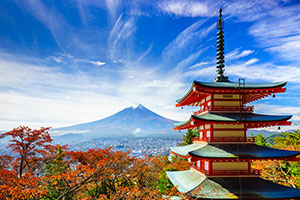MODERATE | RAIL: Take advantage of a two-week Japan Rail Pass to explore Japan’s main island. Starting in Tokyo, you’ll journey to Takayama, Kyoto, and Hiroshima, with day trips to Nikko, Nara, and Osaka along the way. Enjoy the comfort of having travel and accommodations pre-booked, giving you the freedom to explore at your own pace.
Kamakura
Kamakura
The most impressive site in the ancient city and religious center of Kamakura, located 30 mi/50 km south of Tokyo, is the photogenic Daibutsu, a giant 120-ton/108-metric ton bronze statue of the Buddha. The statue has an amazing history: Cast in the 13th century, it originally was housed in a temple about a mile/kilometer farther inland. In 1495, a giant tsunami washed the temple away, and since then the Daibutsu has sat in the open. Kamakura also offers scores of ancient shrines and temples, many of them scattered in the hills that surround the city on three sides. The imposing Tsurugaoka Hachimangu shrine is in the center of town; Zeni-arai Benten (the "money-washing" shrine) is also a favorite pilgrimage spot; Engakuji is one of the oldest and most important Zen monasteries in Japan; and Tokeiji (the Bamboo Temple) is also an atmospheric site. The Museum of Modern Art, Kamakura and Hayama, in the precinct of Tsurugaoka Hachimangu, was designed by a Japanese student of Le Corbusier. Kamakura also boasts one of the closest beaches to Tokyo. You can take a ride on the Enoden, a railway that is part train, part streetcar, that runs along the coast from Kamakura to Enoshima, a traditional pilgrimage spot, and then to Fujisawa, southwest of Yokohama. This journey will give you unique glimpses of the hills and ocean (and some people's backyards).
|
Destination Guide
|
Osaka
Osaka
This large, bustling port is the starting point for tours to the ancient cities of Kyoto and Nara, the cultural fountainheads of classical Japan. Kyoto's Old Imperial Palace and the shogunal Nijo Castle remain glorious symbols of the power the city held for over 1,000 years. Until 1868, Kyoto was the capital of Japan, filled with elegant timber buildings and, perhaps more than any other Japanese city, imbued with Kami, the divine spirit. You'll sense it everywhere, for there are hundreds of Shinto shrines and over a thousand Buddhist temples, as well as sacred treasure-houses of religious sculpture, painting and exquisite gardens. Nara, City of the Seven Great Temples, lies in an idyllic setting.
|
Destination Guide
|
Nara
Nara
Nara was Japan’s imperial capital during the 8th-century, and now is a peaceful provincial town. Visit the lovely Deer Park, surrounding the magnificent Todaiji Temple, and enjoy feeding the deer in the park. Todaiji Temple is famous for its high bronze Buddha housed in the largest wooden structure in the world.
|
Destination Guide
|
Nikko
Nikko
In Nikko, Japan, visit the fabulous Yomeimon Gate and the Toshogu Shrine, the final resting place of the first Tokugawa Shogun.
|
Destination Guide
|
Hiroshima
Hiroshima
Hiroshima in southwestern Honshu has grown rapidly as a commercial city, and after 1868 it was developed as a military base. Every August 6 since 1947, thousands participate in multidenominational services in the Peace Memorial Park built on the site where the bomb exploded. After the war the city was largely rebuilt, and commercial activity gradually resumed. Visit the Peace Park but also explore Miyajima Island and its colourful shrines and mysterious forests.
|
Destination Guide
|
|
Takayama
|
|
Kyoto
Kyoto
If you can visit only one city in Japan, Kyoto is the one. This ancient city, 30 mi/50 km northeast of Osaka, was the capital of Japan for more than 1,000 years and still is considered the country's spiritual capital. Thousands of shrines and temples dot the city, including more than a dozen on the UNESCO World Heritage list. That list is far from all-inclusive, and many excellent places that might be the star attractions of other cities crowd the streets of Kyoto. It is a center of Japanese Zen and has several huge monastery complexes where serious students still sit in meditation. Kyoto is also the nation's capital of traditional arts. Whether your interest be in pottery, textiles, dance, the tea ceremony or any of the other innumerable arts, Kyoto has excellent galleries, museums, shops and tea houses. Japanese people from the countryside and foreign students flock there to learn under the great masters. Much of what is considered Japanese haute cuisine was developed there too, as an offshoot of the tea ceremony. Kyoto is Japan's heartland of history. With 1,300 years of tumultuous existence, the city's past intrudes upon the present day as in few other Japanese cities. In Gion, you can spot a geisha (or geiko, as they are called in Kyoto), one of the last hundred or so in Japan, slipping down a side-street to entertain rich guests with witty conversation, dance or music. A shopping arcade may suddenly fill with discordant clanging music as a shrine festival passes among the shoppers, or you may hear the long chant as Zen monks pass through the neighborhood, calling for alms. Kyoto is an understated city that might disappoint visitors at first (at first glance, it is a large city with modern buildings that might not align with one's original perception); its charm lies in small details, pocket gardens, tiny traditional restaurants and refined artwork.
|
Destination Guide
|
Tokyo
Tokyo
Tokyo, Japan, presents a different view at every turn. It's one of the world's main economic centers and its most populous agglomeration. The business of Tokyo is business, but you can still find harmony and small-scale gardens on back streets. Around the corner from neon and concrete, you may find the bonsai-lined courtyard of a traditional inn. Tokyo was nearly destroyed by bombs and fires during World War II, and by earthquakes at other times, but it has always rebuilt itself. As a result, there is little left of Old Japan in the city, but there's plenty of New Japan to take its place. The streets are a confusing maze, so a map is essential. The transit system is excellent, however, and there are kobans (police boxes) throughout the metropolis, as well as a populace generally willing to answer questions. Visitors to Tokyo represent both business and leisure travelers. And despite its past reputation, Tokyo is no longer fearsomely expensive. It's relatively easy to visit Tokyo on a budget.
|
Destination Guide
|






